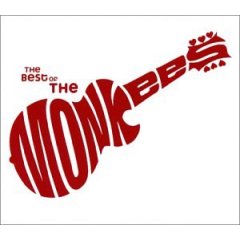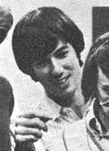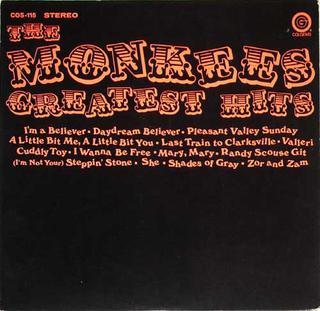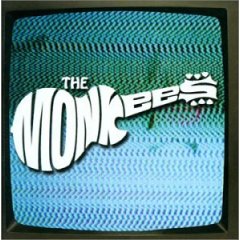
The Monkees were an American pop rock band formed in Los Angeles in the mid-1960s. The band consisted of Micky Dolenz, Davy Jones, Michael Nesmith, and Peter Tork. Spurred by the success of the television show of the same name, the Monkees were one of the most successful bands of the late 1960s. With international hits, four chart-topping albums and three chart-topping songs, they sold more than 75 million records worldwide.

George Michael Dolenz Jr. is an American musician and actor. He was the drummer and one of two primary vocalists for the pop rock band the Monkees, and a co-star of the TV series The Monkees (1966–1968). After the death of Michael Nesmith on December 10, 2021, Dolenz is the last surviving member of the band.

Pisces, Aquarius, Capricorn & Jones Ltd. is the fourth album by the Monkees. It was released on November 6, 1967, during a period when the band exerted more control over their music and performed many of the instruments themselves. However, although the group had complete artistic control over the procceedings, they invited more outside contributions than on their previous album, Headquarters, and used session musicians to complement their sound. The album also featured one of the first uses of the Moog synthesizer in popular music. Pisces, Aquarius, Capricorn & Jones Ltd. sold over three million copies. It was the band's fourth consecutive album to reach No. 1 on the U.S. Billboard 200.

The Best of the Monkees is a Monkees compilation released by Rhino Entertainment. It contains 25 songs from the Monkees' repertoire, listed in chronological order by release date. Also included is a bonus karaoke CD with five tracks. Unlike previous Rhino compilations, this one does not include any material from the 1980s or 1990s reunions, focusing strictly on the band's 1960s output.

Douglas Farthing Hatlelid, better known as Chip Douglas, is an American songwriter, musician, and record producer, whose most famous work was during the 1960s. He was the bassist of the Turtles for a short period of time and the producer of some of the Monkees biggest hits, including "Daydream Believer" and "Pleasant Valley Sunday".

"Daydream Believer" is a song composed by American songwriter John Stewart shortly before he left The Kingston Trio. It was originally recorded by the Monkees, with Davy Jones singing the lead. The single reached No. 1 on the U.S. Billboard Hot 100 chart in December 1967, remaining there for four weeks, and peaked at No. 5 on the UK Singles Chart. It was the Monkees' third and last No. 1 hit in the U.S.
"Daily Nightly" is a song by Michael Nesmith of the Monkees, which appeared on their fourth album, Pisces, Aquarius, Capricorn & Jones Ltd., in 1967, and was featured in two second-season episodes of their television series, "A Fairy Tale" and "Monkees Blow Their Minds".

The Monkees Greatest Hits is the first greatest hits compilation album by the American pop rock band the Monkees, released in 1969 by Colgems Records.

The Monkees Anthology is a two-CD compilation set by the Monkees issued in 1998, and is the first collection to include material from their most recent studio album at the time, Justus. It includes almost all the original singles and B-sides, as well as a TV rarity and one live track.
"Star Collector" is a song written by Gerry Goffin and Carole King in 1967 and recorded by The Monkees. The song is included on their fourth album Pisces, Aquarius, Capricorn & Jones Ltd. It was featured in five second-season episodes of their television series: "The Wild Monkees", "Hitting the High Seas", "Monkees Watch Their Feet", "Monkees in Paris" and "Monkees Mind Their Manor". "The Wild Monkees" uses an early mix of the song, and the other episodes use the released mix.

"Randy Scouse Git" is a song written by Micky Dolenz in 1967 and recorded by the Monkees. It was the first song written by Dolenz to be commercially released, and it became a number 2 hit in the UK where it was retitled "Alternate Title" after the record company (RCA) complained that the original title was actually somewhat "rude to British audience" and requested that The Monkees supply an alternate title. Dolenz took the song's title from a phrase he had heard spoken on an episode of the British television series Till Death Us Do Part, which he had watched while in England. The song also appeared on The Monkees TV series, on their album Headquarters, and on several "Greatest Hits" albums. Peter Tork said that it was one of his favorite Monkees tracks.

The Definitive Monkees is a limited edition Monkees compilation album released in 2001. It contains 29 of the Monkees' greatest hits. The album includes two tracks from the 1980s reunions. The album featured a bonus disc which featured 31 of The Monkees' rarity songs.

Monkeemania (The Very Best of the Monkees) is a two-disc Monkees compilation released in 2011. It contains 57 of the Monkees' songs, including hit singles, B-sides, album tracks and rarities. Several of these songs were unreleased in the 1960s, but were eventually issued on the Monkees' Missing Links archival compilation albums.

The Monkees: Original Album Series is a CD set by The Monkees which includes the first five albums by The Monkees. The CD set was released in 2009 as a slipcased box set.

Monkeemania is a Monkees compilation released in Australia in 1979. It contains 40 of the Monkees' songs, including hit singles, B-sides, album tracks and three previously unreleased tracks: "Love to Love," "Steam Engine" and a live version of "Circle Sky."

"Goin' Down" is a song by the American pop rock band the Monkees, written by all four members of the group along with Diane Hildebrand. It was first released as the B-side to the "Daydream Believer" single on Colgems Records on October 25, 1967, in support of the band's fourth album, Pisces, Aquarius, Capricorn & Jones Ltd. The song managed to bubble under the Billboard Hot 100 upon its release.

Good Times! is the twelfth studio album by American pop rock band the Monkees. Produced primarily by Adam Schlesinger, the album was recorded to commemorate the band's 50th anniversary. It is the first Monkees studio album since Justus (1996), marking the longest gap between releases to date, and the first since the death of Davy Jones. The album features surviving Monkees Micky Dolenz, Michael Nesmith, and Peter Tork, as well as a posthumous contribution from Jones.

Christmas Party is the 13th and final studio album by the American pop rock band the Monkees, released on October 12, 2018, by Rhino Records. Produced mainly by Adam Schlesinger, the album is the Monkees' first to focus on Christmas themes. It follows on the success of their 2016 album Good Times! The album features surviving Monkees Micky Dolenz, Mike Nesmith, and Peter Tork, as well as two posthumous contributions from Davy Jones. It is the final Monkees studio album to be released prior to Tork and Nesmith's deaths in 2019 and 2021, respectively.
"Christmas Is My Time of Year" is a Christmas single written by Howard Kaylan and Chip Douglas, both members of the Turtles.
"Words" is a song written by Tommy Boyce and Bobby Hart and released by the Monkees. An early version by the Leaves appeared on their 1966 album Hey Joe. The Monkees first recorded the song for their second album, More of The Monkees, in August 1966 under the supervision of Boyce and Hart. While this version went unreleased until the 1990 compilation Missing Links Volume Two, it was featured in the 10 April 1967 episode of The Monkees "Monkees, Manhattan Style". A new version of the song was made to be the B-side of "Pleasant Valley Sunday" in 1967, now produced by Chip Douglas.
















